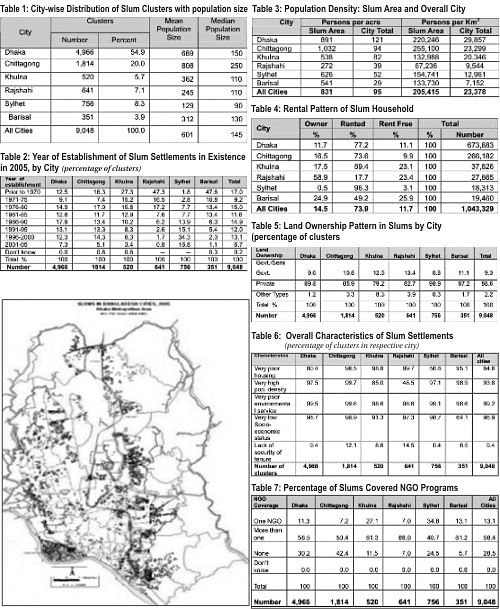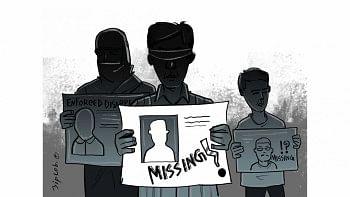Urban slums of Bangladesh

1 The household monthly income of Tk. 5,000 was estimated as the urban poverty line for May 2005 by the CUS study team on the basis of urban poverty line per capita income of TK.906 (or Tk 4344 for an average urban household) for May 2004 determined by the Bangladesh Bureau of Statistics (BBS) and presented in its “Preliminary Report of the Poverty Monitoring Survey, 2004”. p.13.
Background
Though still comparatively rural, Bangladesh has an urban population of about 35 million, or just over 25 percent of its total population. Moreover, the urban population has been growing very rapidly since liberation in 1971 and continues to do so at over 3.5 percent annually. The country will likely have an urban population approaching 50 million by 2015.This rapid growth has been due primarily to migration by the rural poor, particularly to large metropolitan areas. On arrival, these poor migrants routinely turn to slums and squatter settlements for shelter. All major urban centres in Bangladesh have slums and squatter settlements, the largest concentrations being in Dhaka, followed by Chittagong, Khulna, and Rajshahi.
To begin with, there is no difference between a slum and a squatter settlement. The latter are simply slums illegally located on land belonging to the government, semi-governmental units, public organizations and other organizations. Drawing on both international literature attempting to define slums as well as widely accepted definitions or norms applied in the Bangladeshi context; slums are defined as settlements with a minimum of 10 households or a mess unit with a minimum of 25 members and:
* predominantly very poor housing;
* very high population density and room crowding;
* very poor environmental services, especially water and sanitation;
* very low socio-economic status;
* lack of security of tenure
The socioeconomic status of the community is defined by low income, with the majority, or over 50 percent, of households having income below the poverty level of Tk. 5,000 per month , the majority of the labour force in informal sector occupations (e.g. rickshaw pullers, hawkers, domestic workers, etc.) or very low paying formal sector positions (in organizations ranging from factories to offices) and low levels of rent. Another important dimension is whether the settlement is socially perceived as a slum. Finally, security of tenure is captured by vulnerability to eviction.
Slums of Dhaka city
Dhaka, the capital of Bangladesh, is the largest city in the country. It comprises 34 percent of the overall national urban population and is unrivalled among Bangladeshi cities in terms of its economic, social and political opportunities. Dhaka has been growing very rapidly over the last five decades, particularly due to rural to urban migration and urbanization and incorporation of erstwhile outlying areas. Dhaka City Corporation (DCC) has an area of 145 sq. kilometres and an estimated population of 7.2 million (2005). Dhaka Metropolitan Area (DMA), with an estimated 2005 population of 9.1 million, comprises DCC and adjoining areas totalling 306 sq. kilometres. Slums have existed in Dhaka City for a long time but their growth accelerated after the liberation of the country in 1971, mainly due to mass migration by the rural poor. The first significant survey of the slums and squatter population in Dhaka was conducted by the Centre for Urban Studies in 1974 at the behest of the Government of Bangladesh and UNCHS. The slum population found in that survey was 275,000. Another survey was conducted by CUS in the Dhaka Metropolitan Area in 1991 for ICDDR, B. This study recovered a slum population of 718,143 in some 2,156 slum and squatter clusters. CUS conducted yet another survey in 1996 in the same area (the DMA) for the Asian Development Bank and found the total slum population to be 1.5 million in 3,007 clusters.
Year of Establishment of Slum Settlements in Existence in 2005
Slums have been a feature of life in the cities of Bangladesh for a long time. Table 2 presents the year of establishment of those slums found in 2005. It shows that there were quite a significant number of slums in the cities even prior to 1971, the year of independence of the country. By a five-year period intervals the data suggest that the highest period for establishment of slums for all six study cities combined was 197680, which had a concentration of 15 percent of new slums.
Density of population in slums
The average population density in slums was 831 persons per acre or 205,415 people per km2 (Table 3). This density figure is extraordinary, given that almost all residential structures in slum areas were single storey. Density varied from 272 persons per acre in Rajshahi to 1,032 in Chittagong. Dhaka had the second highest density at 891 persons per acre. In Chittagong, the population density in slum areas was 11 times that of the overall city.
Housing conditions
The quality of housing is one of the most basic indicators characterising slum settlements. The majority of slum houses (56%) in the six cities were of very poor quality (weak and temporary structures or kutcha units), while another 42.4 percent were semi-pucca type. A very small proportion (1.1%) was dilapidated older buildings, while only 0.5 percent was good quality homes. The physical quality of slum housing was generally better in Dhaka and very poor in Khulna and Barisal. However, the fact that slums in Dhaka and some of the other towns showed a relatively high prevalence of semi-pucca structures does not automatically allow one to conclude that the overall housing situation there was good since such houses normally had very high room crowding and very low per capita floor space.
Rental pattern in slums
Almost three-fourths (73.9%) of slum households rented their residence, a figure which varied from 17.7 percent in Rajshahi to 96.3 percent in Sylhet (Table 4). In Rajshahi, a high proportion of slum households (58.9%) were owner occupied. A significant proportion of households (around 25%) in Barisal, Khulna and Rajshahi did not pay any rent.
Slum land ownership pattern
Most slum clusters (88.6%) were established on privately owned land. Only 9.3 percent were on public land (i.e. on government and semi-government land). A small number (only 195 of the 9,048, or 2.2 percent) were built on land owned by various other organizations. Sylhet revealed a different picture: there were almost no slums on public land. Other studies have suggested that the proportion of slums on private land has been increasing, mainly due to a rapid decline in the availability of public land. Table 5 shows the pecentage distribution of slum land ownership in the six cities.
Overall Characteristics of Slums
More than 93% of slums were reported to have very high population density and very poor environmental services, and 85% had very poor housing conditions (Table 7). Interestingly, less than 10% of slums seemed to suffer from lack of tenure security. This can be explained by the fact that most were on private land and run on a commercial basis. Sudden evictions were not very common in such slums.
NGO coverage of slums
Nearly three-fourths of the slums (71.5%) received services from one or more NGOs. Barisal and Rajshahi were the best serviced and while the slums of Chittagong benefited least from the efforts of NGOs.
This survey revealed that slum circumstances vary greatly across the six cities. In many instances, there are two overall prevailing situations: the circumstances in the largest cities (Dhaka and Chittagong) and those in the smaller ones. This realization should lead to the casting of a wider net in future studies focusing on slums: the circumstances of the slums of the largest cities of Bangladesh are in all likelihood not particularly representative of those in smaller and medium sized cities. Unfortunately, studies into the causes or consequences of slum life to date in Bangladesh have generally focused on a limited number of slums in Dhaka.
Team Members:
Key Persons
Professor Nazrul Islam, Team Leader; Chairman, University Grants Commission of Bangladesh (UGC) & Honorary Chairman, Centre for Urban Studies (CUS), Dhaka.
Dr. AQM Mahbub, Professor, Department of Geography & Environment, University of Dhaka.
Dr. Nurul Islam Nazem, Professor, Department of Geography & Environment, University of Dhaka and Honorary Secretary, Centre for Urban Studies (CUS), Dhaka.
GIS Team
Mr. Shamim Hasan
Mr. Shahab Uddin
Mr. Tarikul Islam
Database Management
Mr. Mostaque Ahamed
Research Assistants
Mr. A N M Safiqul Alam
Mr. Abu Sayed
Mr. Asadul Islam
City Coordinators
Dhaka : Dr. AQM Mahbub
Dr. Nurul Islam Nazem
Chttagong : Dr. M.Shahidul Islam
Khulna : Dr. Tslima Begum
Mr. Ehsanul Kabir
Rajshahi : Dr. Raquib Ahmed
Sylhet : Mr. Saidur Rahman
Mr. Delwar Hossain
Barisal : Mr. Zahid Hossain
Study Year : 2005

 For all latest news, follow The Daily Star's Google News channel.
For all latest news, follow The Daily Star's Google News channel. 



Comments